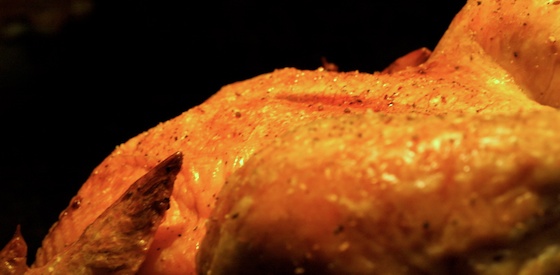 By The Hack
By The Hack
Lookit. Nice, yes?
The Hack fancies himself a reasonable home cook, but one thing he hadn’t explored much (at all) is the roast chicken category, at least not until a couple years ago. Then he tried a few different recipes, including the one in Anthony Bourdain’s Les Halles Cookbook. He tried that one twice, and both times the bird turned out tasting fine, but not worth the work.
(Otherwise, the Hack finds Bourdain’s cookbook quite good, has cooked many items from it, and the roast chicken recipe wasn’t a waste—the herb butter recipe used with the bird was worth the experiment; he prepares that quite often for various uses).
And many recipes are similar to Bourdain’s, involving stuffing the cavity with various aromatics, shoving butter or another fat under the skin over the breast meat, and then often massaging the entire bird in butter as one might wish to douse suntan oil on a buxom bikini contest winner. Once in the oven, there’s often a starting roasting temperature, then after a while, a raising or lowering, basting the whole way through.
And most are just fine. The bird tastes fine. But that’s it. And not, in the Hack’s humble opinion, worth the time and effort.
Enter Thomas Keller.
The Hack had a farm-raised bird sitting in his fridge, a three-pounder. Not eager to start the process of massaging, basting and watching, he typed “simple roast chicken,” or some such phrase, into Google. Up popped this at Epicurious, from Mr. Keller, he of The French Laundry.
Sounded so easy to the Hack, he immediately became suspicious. He knows enough chefs that have the moral convictions of pirates—traits he himself has been accused of sharing—that he believed initially that Keller was holding out a crucial detail to keep the bird moist during the high-heat cooking that produced the crispy skin.
He rolled the recipe over in his noggin, though, and determined it could be the real deal. High heat. Smaller bird. Low-sided pan. Salt.
The Hack followed the recipe exactly (basically, after rinsing and drying, salt and pepper the sucka and cook for an hour at 450 F) with one exception: he used a broiler pan. What could be better than a low-sided pan? A no-sided pan. Juices dripped safely below deck, bird crisped up all the way down low.
(Another good tip: Doc. Biggles at Meathenge recounted in one of his roast chicken recipes that he uses a cast iron pan, sets a trivet in it, and places the bird on the trivet—an outstanding idea.)
The Hack has used this recipe with great success several times since. Moist meat, crisp skin, and with a touch of good mustard on the side as Keller suggests, it’s fabulous. The key is a great bird, not the commodity fryer available in any grocery store. That bird’s meat just won’t stand up flavor-wise to such minimal adornment, and some of them are injected with brine, which will screw everything up. Pay the money for a farm-raised bird, it ain’t that much more, and you won’t go back. Plus, you’ll want to eat all leftovers, an act which adds to overall savings, no?
Adjustments:
There are occasions where the only available bird is larger than two or three pounds. Don’t fret. The Hack has made successful adjustments in temperature and time. Why, just last week, The Hack’s lovely wife bought a 4.5 pound bird. Guests were coming over. The Hack rolled his brain around and ran with this: He cut a wad of excess fat from the back end, and wedged it under the legs he lashed together above the breast—added protection for the longer roasting time required. Then he roasted it at 375 F for about 40 minutes, then cranked it up to 425 for another 30. Spun the pan a 180 degree turn at the temp shift, since he was standing there. Perfect. The added fat slab crisped up too, which made a nice, crunchy, salty snack. And you can poke in the thigh with your meat thermometer just to sooth any worries as you go, but eventually, you’ll be able to eyeball done-ness.
Best roast chicken recipe ever? For its simplicity and result, Bloated Belly HQ declares it so.
